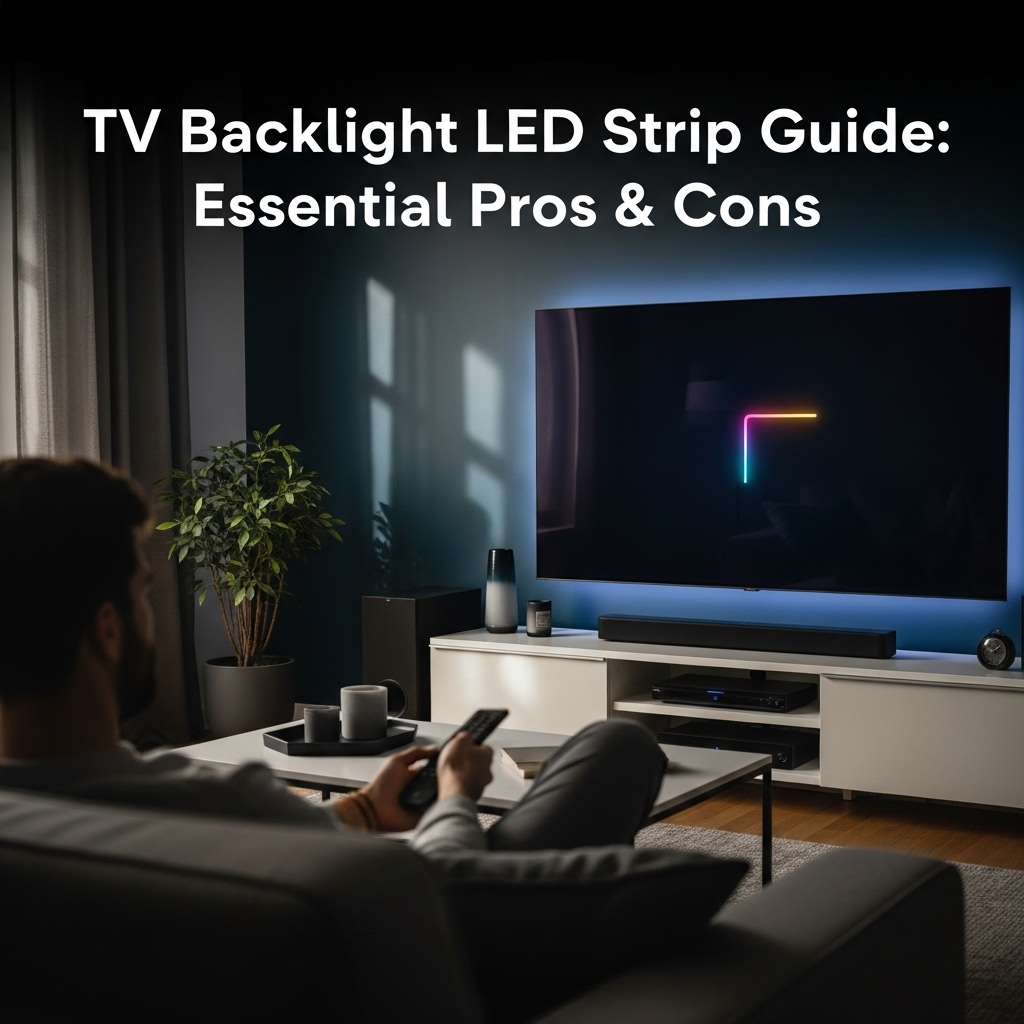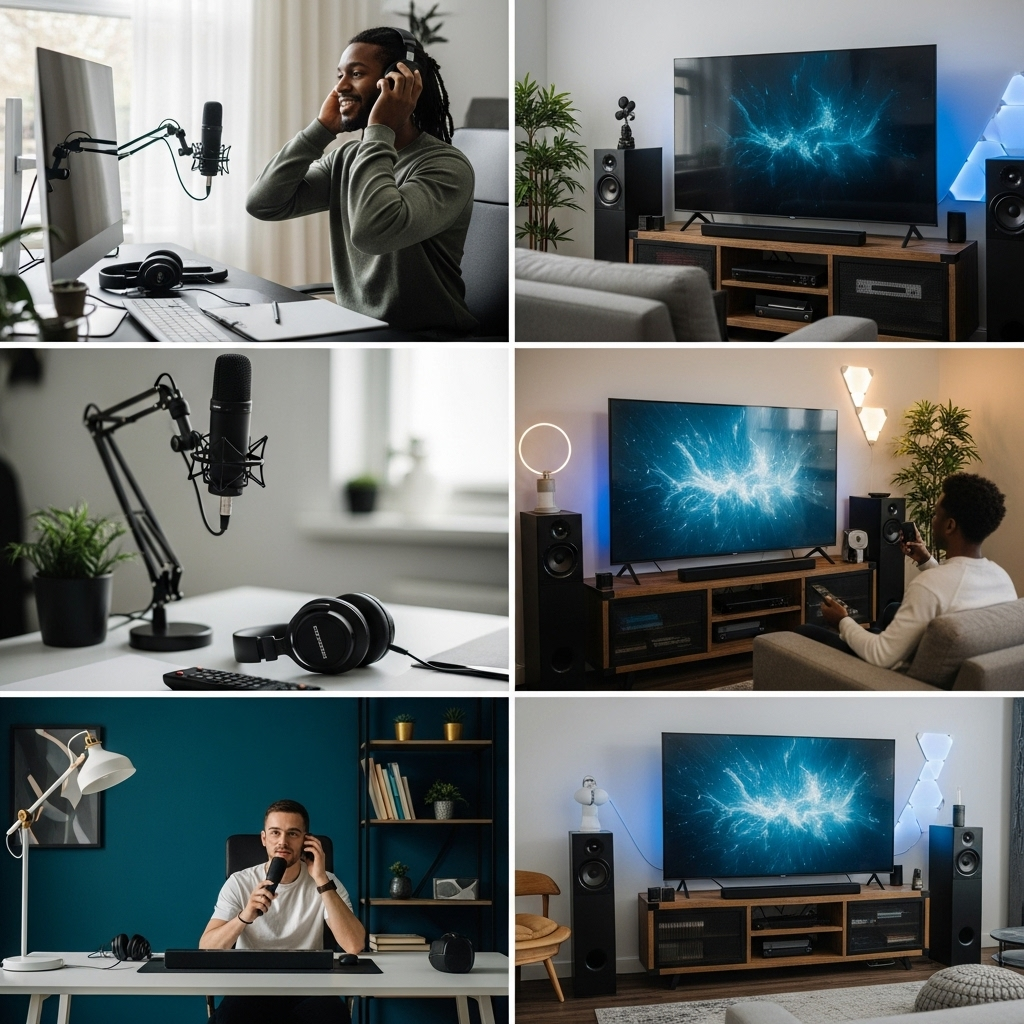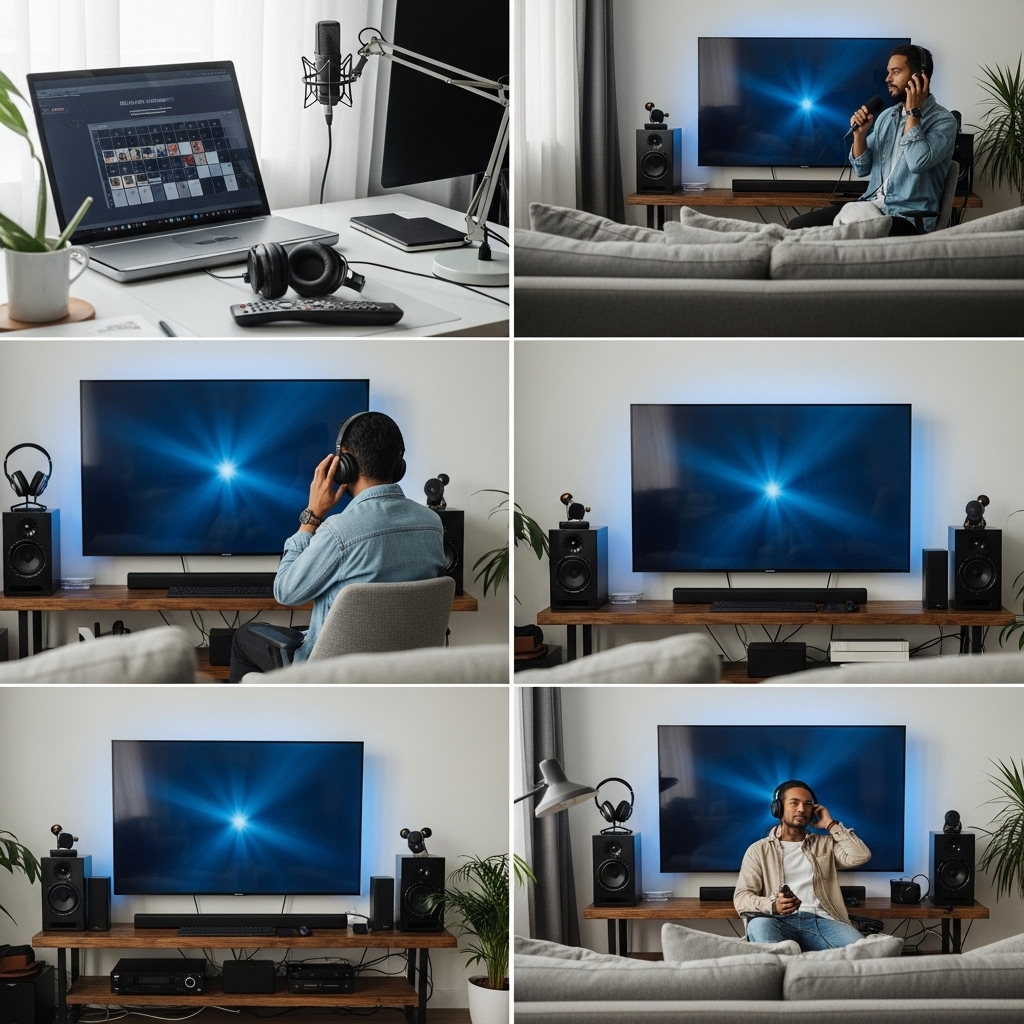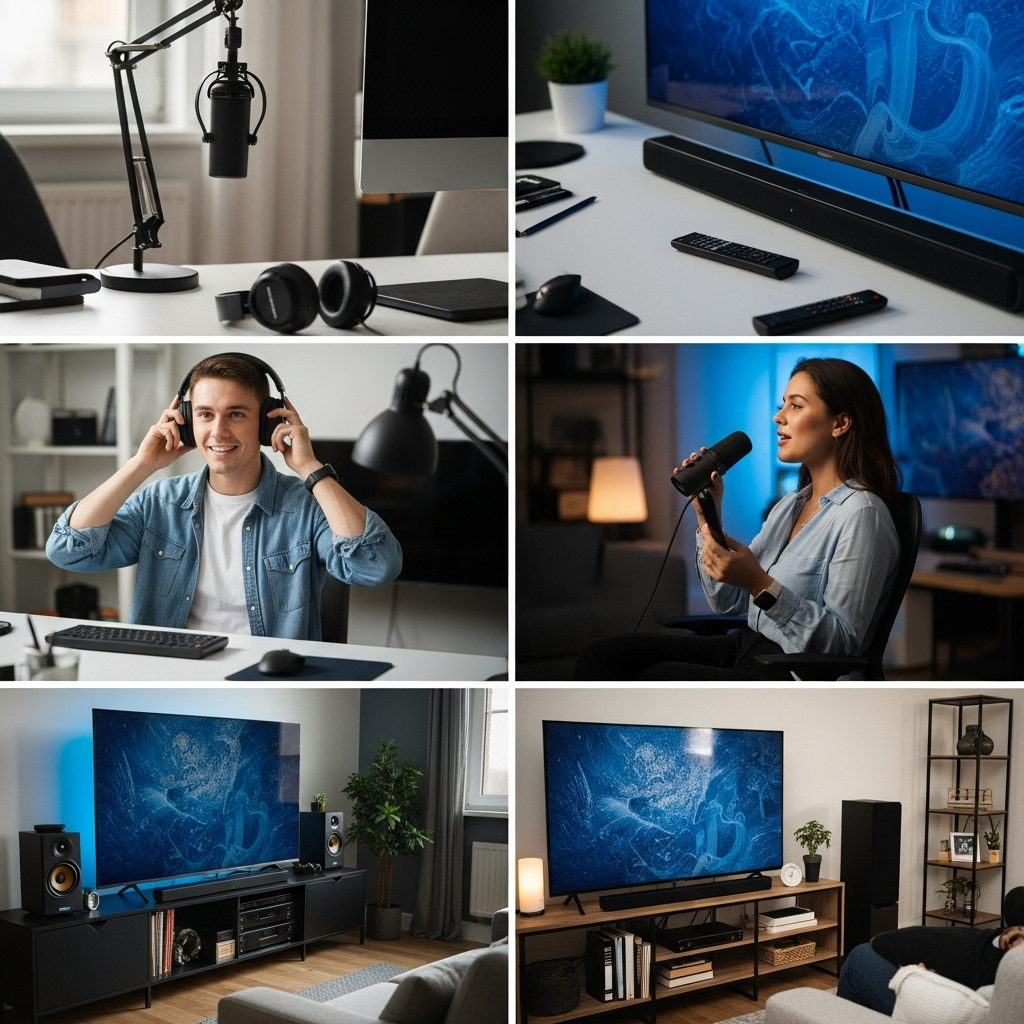Quick Summary: A TV backlight LED strip enhances viewing with ambient light, reducing eye strain and adding a cool aesthetic. While pros include improved immersion and reduced glare, cons can involve complex installation and potential color inaccuracies. This guide helps you weigh the benefits and drawbacks for your home entertainment setup.
Hey there, entertainment aficionados! Bob E Riley here from Aimguider. Ever looked at your TV and thought, “It could use a little something extra”? That feeling often pops up when you’re surrounded by darkness, staring at a bright screen. It can strain your eyes and make your favorite movies or games feel a bit flat. That’s where TV backlights come in, and specifically, LED strips are a popular choice right now. But are they really worth it? We’ll break down the good, the bad, and the colorful, so you can make a choice that’s perfect for your viewing pleasure. Ready to light up your screen?
What is a TV Backlight LED Strip?
Simply put, a TV backlight LED strip is a flexible band of tiny lights, called LEDs, that you stick to the back of your television. The main goal is to cast a soft glow onto the wall behind your TV. This isn’t just for looks; it actually helps your eyes. When you watch TV in a dark room, the bright screen against a black background can cause something called the “pupil fluctuation” effect. Your pupils are constantly adjusting, which can lead to eye fatigue. A backlight provides a gentle, consistent light source that makes this transition smoother. Think of it like a twilight for your eyes, making those late-night viewing sessions much more comfortable.
Why Add an LED Backlight to Your TV?

You might be wondering why so many people are adding these colorful strips to their TVs. It’s not just about making your setup look cool, though that’s a big part of it! The primary reason is to create what’s known as “bias lighting.” This type of lighting is designed to illuminate the area surrounding your display without directly shining on the screen. This helps to:
- Reduce Eye Strain: As mentioned, a soft glow on the wall eases the harsh contrast between a bright screen and a dark room.
- Enhance Picture Quality Perception: By providing a more balanced visual environment, colors might appear richer, and the overall viewing experience can feel more immersive.
- Create Ambiance: Many LED strips come with a wide range of colors and effects, allowing you to set the mood for movies, gaming, or parties.
- Improve Contrast Ratio: While it doesn’t change your TV’s actual contrast ratio, the perceived contrast can feel more dynamic.
The Pros of TV Backlight LED Strips
Let’s dive into what makes these LED strips so appealing. They offer a fantastic way to upgrade your home theater experience without breaking the bank. Here are the main advantages:
1. Enhanced Immersion and Viewing Experience
One of the biggest benefits is how much more engaging your content can become. When the light from the LED strip spills onto the wall behind your TV, it can create a gentle halo effect. This subtle glow helps to blend the edges of the screen into your surroundings, making it feel like the picture is extending beyond the physical boundaries of your TV. For movies, especially those with wide aspect ratios or sweeping landscapes, this can make you feel like you’re right there in the action. Gamers often rave about this too, as it can make fast-paced games feel even more intense and enjoyable.
The effect is particularly noticeable with darker scenes. Without bias lighting, bright objects on a dark screen can appear to “pop” unnaturally, straining your eyes. With the backlight, the contrast is softened, making dark scenes more comfortable to watch for extended periods. It’s like having a tiny bit of the cinema experience right in your living room.
2. Reduced Eye Strain and Fatigue
Staring at a bright screen in a completely dark room is like looking directly into a spotlight for hours. Your pupils have to make big adjustments. Over time, this can lead to tired eyes, headaches, and general discomfort. An LED backlight acts as a buffer, providing a soft, ambient light that helps your pupils relax. This creates a more comfortable viewing environment, especially for long movie marathons or late-night gaming sessions. Many users report a noticeable difference in how their eyes feel after installing a backlight.
This benefit is supported by general lighting principles. The American Optometric Association recommends having some ambient light when viewing screens to reduce digital eye strain. While a full room light is ideal, a well-placed TV backlight is a great compromise when you want that cinematic feel without turning on every light in the house.
3. Customizable Ambiance and Aesthetics
Let’s be honest, LED strips look cool! Many modern TV backlight kits, especially those that are “smart” or addressable, offer a dazzling array of customization options. You can choose from millions of colors, adjust brightness, and even select dynamic lighting effects like chasing colors, pulsing lights, or smooth transitions. This allows you to tailor the mood of your room to match your content or your preference.
Imagine setting a cool blue hue for a sci-fi movie, a warm orange for a cozy drama, or a vibrant, synchronized display for a party. Some advanced systems can even sync the lights with the on-screen action, reacting in real-time to the colors and movements of your video content. This adds a whole new dimension to your entertainment setup, making your TV a dynamic centerpiece.
4. Relatively Low Cost and Easy Installation
Compared to other home theater upgrades like a new soundbar or a larger TV, LED backlight strips are incredibly affordable. You can find effective kits for as little as $20-$50, with higher-end or smart options going for a bit more. For the significant improvement in viewing comfort and aesthetic appeal they provide, the value is excellent.
Installation is typically very straightforward. Most strips come with a strong adhesive backing, allowing you to simply peel and stick them to the back of your TV. You then connect them to a power source (usually a USB port on the TV itself or a wall adapter) and, if applicable, a small control box or receiver. For most users, this process takes less than 30 minutes and requires no special tools.
5. Energy Efficiency
LEDs (Light Emitting Diodes) are known for their exceptional energy efficiency. They consume significantly less power than older lighting technologies like incandescent or fluorescent bulbs. This means your TV backlight won’t drastically increase your electricity bill. Even when on for extended periods, their power draw is minimal. This makes them an environmentally friendly choice as well as a cost-effective one.
The Cons of TV Backlight LED Strips

While the benefits are compelling, it’s important to be aware of the potential downsides. No tech is perfect, and understanding these drawbacks will help you make an informed decision.
1. Potential for Glare and Uneven Lighting
If the LED strip is too bright, or if it’s placed incorrectly, the light can reflect off the wall and create a visible glare on your screen. This is counterproductive, as it can distract from your viewing and potentially increase eye strain. Achieving good, even lighting often requires careful placement and adjustment of the brightness. Sometimes, adding a diffuser (if not included) or ensuring the strip is positioned further back from the TV can help mitigate this issue.
The angle at which the strip is mounted is crucial. If it’s too close to the center of the TV’s back or angled directly towards the screen, glare becomes a higher risk. It’s generally recommended to position the lights towards the outer edges of the TV’s back, directing the glow outwards onto the wall.
2. Color Accuracy and Syncing Issues
Not all LED strips are created equal. Cheaper or older models might not produce pure, accurate colors. This can be frustrating if you’re trying to achieve a specific mood or if you’re using a system that syncs lights with on-screen content. The colors might look muddy, off-white, or just not quite right. Similarly, if you’re aiming for advanced synchronization features where the lights mimic the on-screen action (like with systems such as Philips Hue Sync or Govee Immersion), lower-end or poorly implemented systems can suffer from lag or inaccurate color matching, which can be more distracting than helpful.
For the best color reproduction and syncing performance, it’s often worth investing in reputable brands known for their quality and technology. Reviews are your best friend here to identify which products deliver on their promises of vibrant and accurate colors.
3. Installation Challenges and Cable Management
While often described as easy, installation can sometimes be trickier than it looks. If your TV has a heavily textured back, deeply curved edges, or an array of ventilation grilles, sticking a strip securely can be problematic. Some users find they need to use additional mounting clips or double-sided tape. Running the power cable from the strip to the power source can also be a messy affair if you don’t plan your cable management carefully, potentially detracting from the clean aesthetic you’re aiming for.
For very large TVs, you might need to purchase extension cables or multiple strips to cover the entire perimeter, adding complexity. Ensuring the strip doesn’t interfere with TV wall mounts is also a consideration for some users.
4. Limited Benefit for Wall-Mounted TVs with Minimal Space
If your TV is mounted very close to the wall, with little to no gap, there might not be enough space for the light to diffuse properly. The LED strip might end up creating harsh lines of light on the wall rather than a soft glow. In such cases, the aesthetic and eye-comfort benefits are significantly reduced. You might need to strategically position the TV further from the wall or opt for a different type of ambient lighting solution.
This is especially true for slim-profile wall mounts. The ideal setup allows for at least a few inches of space between the back of the TV and the wall for the light to spread out evenly.
5. Potential for Malfunction or Short Lifespan
Like any electronic device, LED strips can eventually malfunction or burn out. Cheaper, unbranded kits might have a shorter lifespan or be more prone to issues like flickering LEDs or unresponsive controllers. While LEDs are generally very durable, the adhesive, connectors, and control electronics can be points of failure over time, especially with constant use and fluctuating temperatures.
Investing in a reputable brand with a good warranty can help mitigate this risk. Looking for strips made with high-quality components can ensure longevity.
Types of TV Backlight LED Strips
Not all LED strips are created equal. Here’s a quick rundown of the main types you’ll encounter, helping you choose the right one for your needs:
1. Basic Color-Changing (RGB) Strips
These are the most common and affordable. They offer a range of colors that you can select using a remote control. You typically change a single color for the entire strip. They provide basic ambiance and can help reduce eye strain, but they don’t offer dynamic effects.
2. Addressable RGB (ARGB) / Dreamcolor Strips
These are more advanced. Each LED or a small group of LEDs can be controlled individually. This allows for amazing effects like “chasing” lights, rainbow patterns, and smooth color transitions. They offer a much more dynamic and visually exciting experience.
3. Wi-Fi/Bluetooth Controlled Smart LED Strips
These strips connect to your home Wi-Fi or Bluetooth, allowing you to control them via a smartphone app. This often unlocks more features, including scheduling, scene creation, and integration with voice assistants like Alexa or Google Assistant. Some smart kits also include music synchronization modes.
4. HDMI Sync LED Strips
These are the most sophisticated and usually the most expensive. They come with a control box that connects to your TV’s HDMI output (or sometimes between your source device and the TV). The box analyzes the video signal in real-time and adjusts the LED strip’s colors and patterns to perfectly match what’s appearing on your screen. This provides the ultimate immersive experience, turning your wall into an extension of the on-screen action. Brands like Philips Hue Play Gradient and Govee’s Immersion series are well-known for this. For more on how these sync technologies work, you can check out resources on display technologies, such as those found on the DisplayMate website, which often discusses the technical aspects of visual quality.
Key Features to Look For

When shopping for a TV backlight LED strip, keep these features in mind:
- Length: Measure the perimeter of your TV (back side) to ensure the strip is long enough. Most kits offer options for different TV sizes.
- Adhesive Quality: Look for strong, reliable adhesive (e.g., 3M) that won’t lose its grip over time.
- Color Options & Brightness Control: Ensure it offers a good range of colors and adjustable brightness.
- Control Method: Decide if you prefer a simple remote, a smartphone app, or advanced HDMI syncing.
- Power Source: Many strips can be powered via the TV’s USB port, which is convenient as it turns on/off with the TV. Otherwise, a wall adapter is needed.
- Durability & Warranty: Check for quality construction and a decent warranty.
Pros vs. Cons Table
To help you visualize the trade-offs, here’s a summary table:
| Pros | Cons |
|---|---|
| Enhances viewing immersion | Potential for screen glare if poorly installed |
| Reduces eye strain and fatigue | Color accuracy may vary; cheaper models can be off |
| Customizable ambiance and aesthetics | Installation can be tricky with complex TV backs or mounts |
| Affordable upgrade option | Limited benefit for TVs mounted flush to the wall |
| Energy-efficient (LED technology) | Risk of malfunction or a shorter lifespan on budget options |
| Easy to install for basic models | HDMI sync models can be expensive and complex |
How to Install a TV Backlight LED Strip (Basic Steps)

Installing a typical LED strip is quite simple. Here’s a general guide:
- Clean the TV Back: Ensure the rear surface of your TV is clean, dry, and free of dust or grease. This is crucial for the adhesive to stick properly. Use a lint-free cloth.
- Measure and Cut (If Necessary): Most LED strips can be cut at designated points (usually marked with a scissor icon). Measure the perimeter of your TV and cut the strip to size if it’s too long. Make sure not to cut anywhere else, as this will damage the strip.
- Plan the Layout: Decide where you want to place the strip. A common approach is to run it along the outer edges of the TV’s back. Consider where the power cable will run.
- Peel and Stick: Carefully peel the backing off the adhesive strip and apply it firmly to the back of your TV. Work in sections, pressing down gently but firmly as you go.
- Connect Components: Connect the LED strip to the control box, and connect the control box to the power source (USB or power adapter).
- Power Up and Test: Plug in the power source. Turn on your TV and the backlight. Use the remote or app to cycle through colors and brightness levels to ensure everything is working correctly.
- Cable Management: Use any included cable clips or ties to tidy up the wires for a clean look. Some people opt for raceways or zip ties to hide cables neatly.
For HDMI sync systems, the installation will involve connecting the sync box between your video source (like a streaming device or game console) and the TV, which adds a few extra steps. Always refer to the specific manufacturer’s instructions for your kit.
Frequently Asked Questions (FAQ)
Q1: Will a TV backlight LED strip void my TV warranty?
A1: Generally, no. Attaching an LED strip to the back of your TV, especially one powered by USB, typically does not affect your TV’s manufacturer warranty. It’s not modifying the TV’s internal components. However, always check your TV’s specific warranty documentation to be sure.
Q2: How long do TV backlight LED strips usually last?
A2: The lifespan of LED strips can vary greatly depending on the quality of the components. Reputable brands with good quality LEDs can last 20,000 to 50,000 hours. Cheaper, unbranded strips might have a much shorter lifespan, sometimes only a few thousand hours, or be prone to flickering sooner.
Q3: Can I use a regular LED strip for my TV?
A3: Yes, you can use standard RGB LED strips. However, dedicated TV backlight kits often come with features like USB powering (so they turn on/off with the TV), specific lengths for TV sizes, and sometimes better adhesive designed for TV surfaces.
Q4: Do I need to turn off the backlight
